![]() Papua New Guinea Village Homestay… I am blaming it all on Tim Flannery. I used to think I was quite adventurous until I read “Throwim Way Leg” about his adventures in PNG.
Papua New Guinea Village Homestay… I am blaming it all on Tim Flannery. I used to think I was quite adventurous until I read “Throwim Way Leg” about his adventures in PNG.
As a keen diver and underwater photographer, Papua New Guinea is one of my favorite places in the world. And I have been lucky enough to visit the country many times over the past 20 years or so.
But when I read about Tim’s extended field trips into the remotest parts of the country I felt a little bit like Homer Simpson watching the Discovery Channel….
My tales of diving many of the best locations in Papua New Guinea. And the things I have seen and photographed. All seem like pale imitations of the adventures that Tim describes so eloquently and (at times) hilariously in his book!
I started to feel that the comfort of en-suite rooms at dive resorts. And air-conditioned cabins on liveaboard dive boats had made me soft… So if I wanted to experience Papua New Guinea I needed to get out and really immerse myself.
So when the chance came to try a Papua New Guinea village homestay while spending time at Tufi Dive Resort I jumped at the chance!
Papua New Guinea Village Homestay – Cape Nelson and its Fiords
The Cape Nelson area of Oro Province is one of the most scenically spectacular areas of PNG. And it’s no mistake that Tufi is universally referred to as “Beautiful Tufi”.
What makes the area so special and unique are the “tropical fiords” that line the coast of Cape Nelson. The area’s unique topography is the result of an ancient eruption of three volcanoes on Cape Nelson. The lava flow from which created the long and narrow coastal inlets as it poured into the Solomon Sea.

Geologists refer to such coastal inlets as rias, because a true fiord is created by glaciers. Large but slow moving rivers of ice that carve out the U shaped canyons over thousands of years. With the fiord being what remains after the climatic conditions change and the ice melts.
However everybody refers to the Tufi rias as fiords… And I have to say that tropical fiords sound way cooler than tropical rias!
Visually the fiords are stunning and the dive resort is built on the site of the original pub and hotel. Which served the small expatriate community when Tufi was a settlement for the Australian Administration prior to independence. The views are simply spectacular.
Tufi fiord, together with its northern & southern neighbors Maclaren Harbor & Amuian Bay, are the three largest but there are a total of 17 significant fiords on Cape Nelson.
Papua New Guinea Village Homestay – Ecotourism

Ecotourism is inherently more of a concept than a specific template to be followed.
Well done, it allows the casual visitor to experience an aspect of a specific culture. But without a total immersion that may be a little more “real” than is actually desired.
My personal definition of good ecotourism is an opportunity to go deeper into a local culture. One that would not normally be available and that benefits all parties equally.
The “win-win” outcome is essential… Because if the casual visitor is to benefit the experience must be a natural one. Rather than something that appears to have been carefully choreographed and stage-managed.
For the local people to benefit, there obviously must be some financial gain… But I think the key to success is a feeling of real pride in demonstrating fundamental aspects of their culture to the visitors.
In this age of globalization, where borders and boundaries are rapidly disappearing. The great danger is that we all becoming very similar. Specific cultures that are outside of this globalization mainstream become both more interesting, and more valuable.
So if providing access to those cultures makes their owners feel good. And it makes them some extra money, then count me in!
Papua New Guinea Village Homestay – Here We Go…

So it was with truly noble intent that the following day Jim Hancock, myself and our guide William set off from Tufi. Heading south along the coast in one of the resort’s dive boats to Jebo village – two fiords down from Tufi fiord.
It was an interesting combination because Jim is a really nice guy, roughly half my age, who had traveled all the way to Tufi because he had read one of my articles on the diving there!
Not only had he been convinced by what I had written about the diving at Tufi. But he had also traveled all the way from the Maldives, where his day job was the Cruise Director on one of the most luxurious liveaboards working the islands there!
Jim’s mindset on the homestay was remarkably similar to mine. Just go with the flow and see what happens… But it turned out that we had similar underlying concerns…
Such as would we be able to drink the water, would we get malaria from all the mosquito bites, what would the food be like.
Most importantly… would the beer that had been packed for us stay cold? And where could we go to the toilet, being just a few of the dark thoughts we later admitted to!
Papua New Guinea Village Homestay – Mine Host
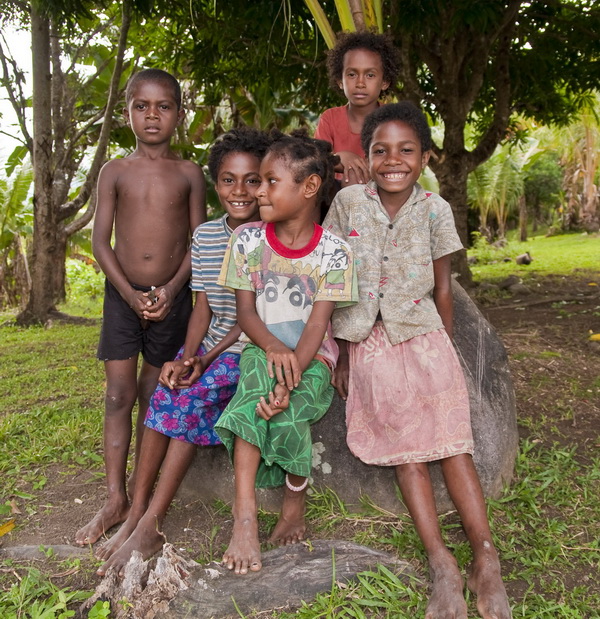
The boat journey to Jebo took less than 30 minutes. Waiting for us on the beach were a group of kids who seemed very excited to see us!
Plus and our host Jackson, whose guesthouse we would be staying at in the village of Orotoaba.
Jackson is typical of many Papuans I have met in rural areas of PNG. Initially reserved and watchful, then once that ice is broken and he has your measure, you find a raw intelligence and command of the surroundings that is both fascinating and worthy of deeper engagement.
He quickly organized a couple of the teenage kids as porters for our bags. Then it was off through the rising hills and rich kunai grass to Orotoaba.
With Jackson and our guide William in the lead, Jim and I followed with the teenagers. Quickly leaving the beach behind us as we made our way through the kunai grasslands.
About one hour later we entered Orotoaba to be greeted by another group of excited kids. Together with a pot of very nice, freshly made tea in a rather battered looking tin teapot. Taken in the specially built “dining room” next to Jackson’s house.
What Jackson has done is take a piece of land, about 100m from his house on the eastern side of the village facing the sea.
And then built a detached guest house with three bedrooms and separate toilet and bathroom buildings. This allows the guests their own space and privacy just away from the village. But as Jackson’s wife cooks all meals in her kitchen, the food is transferred to the dining room where the guests gather to eat.

Papua New Guinea Village Homestay – The Village
Orotoaba appeared very similar to many other coastal villages I have visited in PNG. With well laid out neat and tidy houses made of bamboo and a common grass area that is communally maintained. The focal point of the village is the church, which is again very typical of many other villages.
Jackson introduced us to all the villagers we encountered on the way. All of whom seemed to regard us with an equal mixture of curiosity and concern. The curiosity was easy to understand, after all here were two white guys who had given up a night in the sort of resort the villagers could barely perceive of, let alone stay at, to come to their village.
The concern was a bit harder to rationalize. Then it dawned on me that they were just nervous that their basic living conditions would be looked down upon. Life is a relative thing in my experience… And that flicker of concern in the villager’s eyes, as they showed us their homes, brought back the intense feeling of inadequacy I remember feeling many years ago when a rich uncle came to visit our humble “council house” in the working class UK I grew up in.
Of course there was no way to properly communicate that empathy. So I just had to do my best to put the villagers at ease and thank them sincerely for sharing a small vignette of their lives with me.
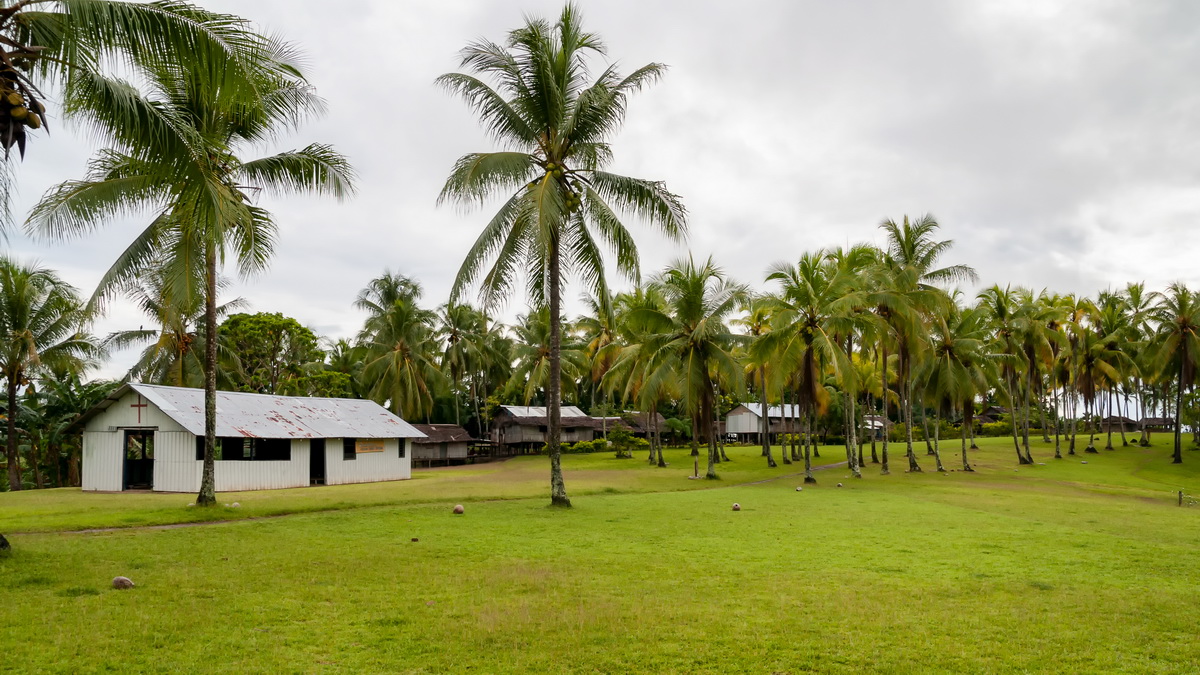
Papua New Guinea Village Homestay – Subsistence Living
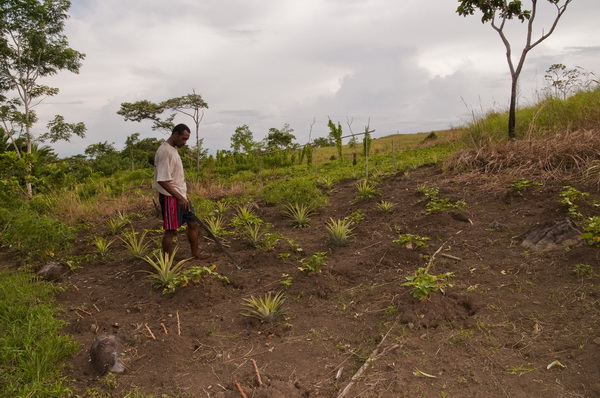
Virtually all village life in PNG is subsistence living. Which means that the villagers grow the majority of what they eat in small gardens cleared from the jungle and bush.
In a location such as Orotoaba, its proximity to the sea provides an abundance of marine life – an excellent source of additional food. Then of course there are the ubiquitous pigs, so greatly prized by Papuans.
Luxuries such as clothes, washing powder and kerosene for lighting are bought by selling vegetables and fish at the market or to the resort. And whenever possible hand-made handicrafts to tourists such as Jim and myself…
Jackson showed us some of the bush gardens on the way to see the Ibura Bay fiord and its splendid waterfall. I came away with a determination to never complain again about having to buy vegetables for my wife at the local market on a Saturday morning!
Papua New Guinea Village Homestay – Fine Dining
So after a long and interesting afternoon Jim and I sat on the guesthouse veranda sharing our thoughts on village life over a (still…) cold beer. Then we took turns to use the toilet and bathroom facilities (more to follow…) in preparation for dinner served just as darkness descended on the village.
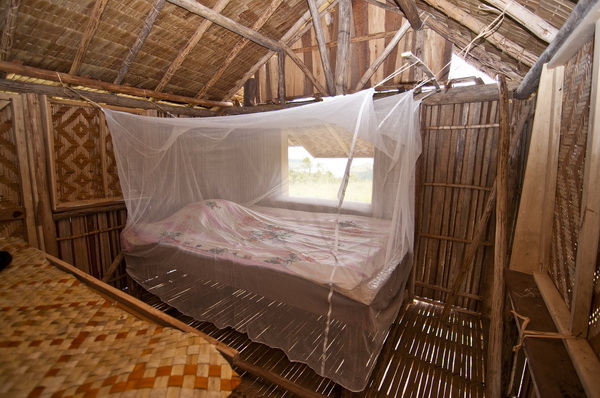
Tufi Dive Resort have worked with many of the local villagers offering homestays to help them understand what to serve and how to prepare the meals properly.
So I was rather curious to see what fine dining in Orotoaba would be like now that the day’s activities had equipped me with a significant hunger!
Jim and I were very pleasantly surprised to be served several plates of fresh vegetables and local seafood. Cooked excellently and served with a strong sense of pride by Jackson and his wife.
Basically we could not have asked for more. So it was with an intense feeling of satisfaction that I carefully arranged the mosquito netting around my bed and then settled down for a great nights sleep in the guesthouse.
Even though it was only just after eight at night…
Papua New Guinea Village Homestay – Birds Of Paradise
The mountains to the west of Orotoaba are home to a vast array of bird life. Including the Raggiana Bird of Paradise and our guide William came with us to take Jim & I to see them.
However, that involved a very early morning departure from Orotoaba and a walk of about 1.5 hours through the rainforest.
I went to bed determined to be up early, raring to go in the morning. But from about midnight the heavens opened and heavy rain had fallen constantly through the night. So by the time the alarm went off at 04.30 my enthusiasm meter was reading zero.
I was actually able to rationalize this to myself quite easily… First of all I did not have the long telephoto lens with me that would be required to photograph the Bird of Paradise. Secondly, the torrential rain that was still falling would soak my camera backpack and damage all my expensive gear.
Jim on the other hand was clearly not convinced by my feeble excuse and went off with William – who simply shrugged and got on with the task in hand.
I allowed myself the luxury of sleeping till first light, when the rain obligingly stopped, and then after performing my morning’s ablutions (more to follow…) I set off to photograph the village as it came to life.
Jim and William returned triumphantly around mid morning with tales (but no pictures…) of the bird life, including an encounter with the Raggiana Bird of Paradise!
Papua New Guinea Village Homestay – Breakfast…
Jim and William’s return was the signal for Jackson’s wife to serve breakfast and another excellent pot of tea in the battered teapot. It was also apparently the signal for the villagers to come and chat, something the open windows of the dining room allowed them to adopt a 3D multi-directional approach.

This interaction went on for over two hours and was for me probably the highlight of the homestay. The basic mechanism is that if you live in a village without mains power there is virtually no access to external sources of information such as TV or the Internet. So anybody from outside the village is a source of potential “news”. If, like Jim and I, the visitors are from a long way away then they must be in possession of some really newsworthy information and the villagers want to hear it!
So for the next two hours Jim & I embarked on a rambling and mutually beneficial interaction with the villagers.
The discussions ranged from them trying to understand where we were from and how we lived. To us asking about local traditions and culture such as the face tattoos worn by many of the women.
These interactions are really something to treasure because they are a great leveler, giving you a tremendous insight into village life and putting many of the issues of modern life into perspective.
For example at that point in time the cost of petrol back in Sydney made me think twice about the cost of a day trip down the coast. But here in Orotoaba it meant that kerosene for lighting and cooking became just too expensive to even consider buying!
Papua New Guinea Village Homestay – Ablutions…
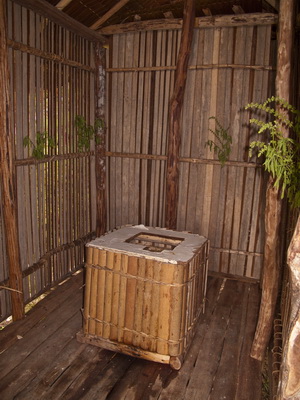
I simply have to share this story with you. When we arrived back at the guesthouse after the village and waterfall tour with Jackson, I felt the need to avail myself of the toilet facilities.
Now I have to state that camping is not really my thing and bush toilets are somewhat of a mystery to me. So it was with a sense of foreboding that I drew back the curtain on the “drop toilet” at the guesthouse.
It turns out that the toilet was kind of a thunderbox built over a deep pit. And once I had worked out the score was about to use it when something made me think of ants and spiders just waiting for me to expose myself to them!
Sure enough a quick check with the torch revealed a small colony of ants patrolling the general area of the toilet seat…
Nature being what it is, somehow I had to deal with this and then I remembered the can of mosquito spray in my bag, which I swiftly retrieved and promptly rendered the toilet safe to proceed.
Unfortunately, the following morning I forgot all about the ants and seconds after assuming the position felt a biting sensation on what is possibly the most vulnerable and definitely the least exposed part of my anatomy. I have rarely moved so fast, so early in the morning, as I did that day in Orotoaba!
So interesting, love it! Have always been fascinated with Papua. While at primary school in Brecon, Wales, there was a colourful picture pinned to the wall behind my desk of 2 Papua girls in grass skirts standing outside their attractive thatched hut. That picture charged my imagination ever since. Sadly, I never made it to Papua, but I was able to spend holidays on other tropical island I fell in love with, such as Mahe/Seychelles, Ceylon (later renamed Sri Lanka), Pulau Pinang/West Malaysia and Zanzibar/Tanzania. All stunning in similar ways…